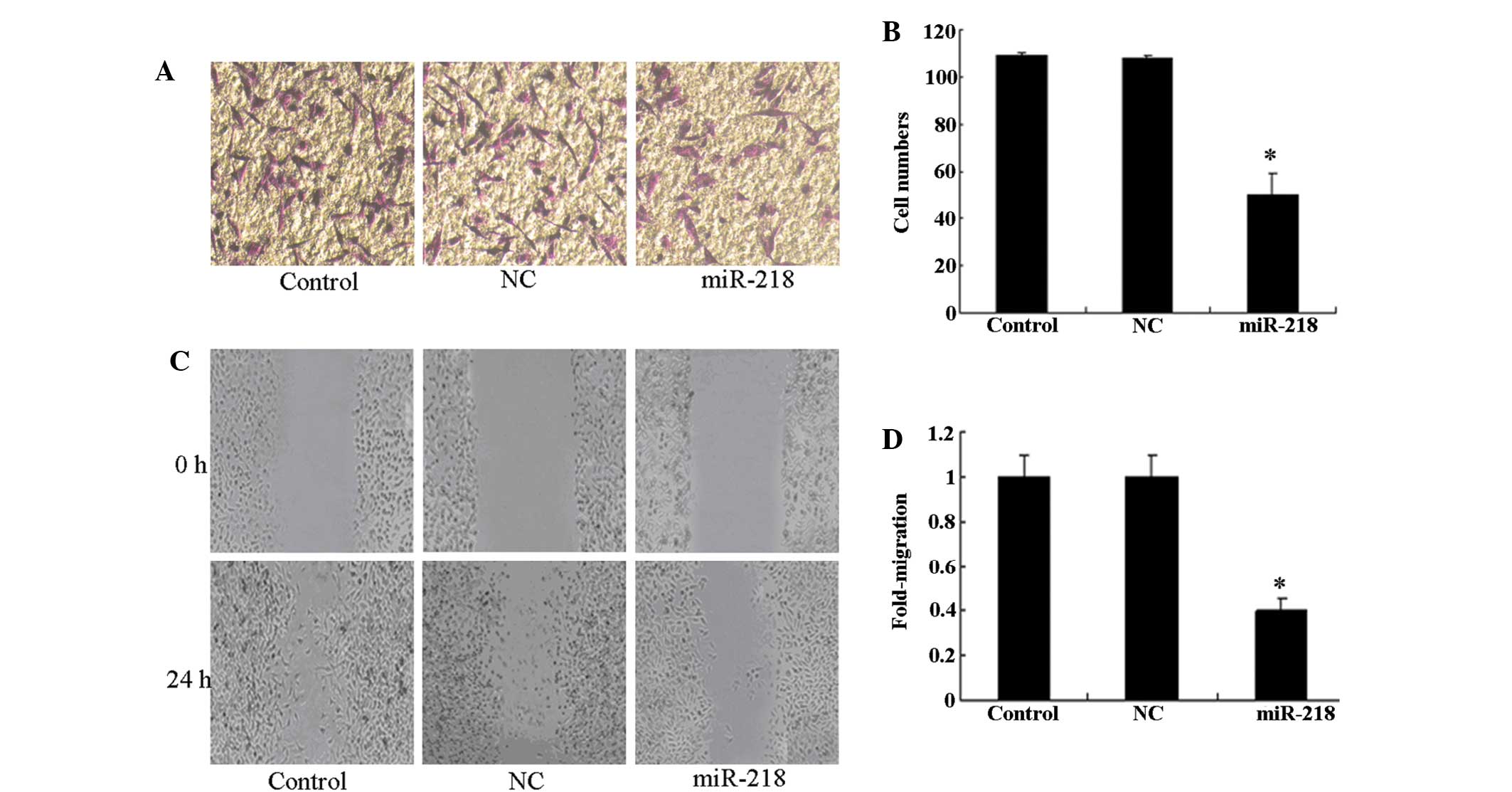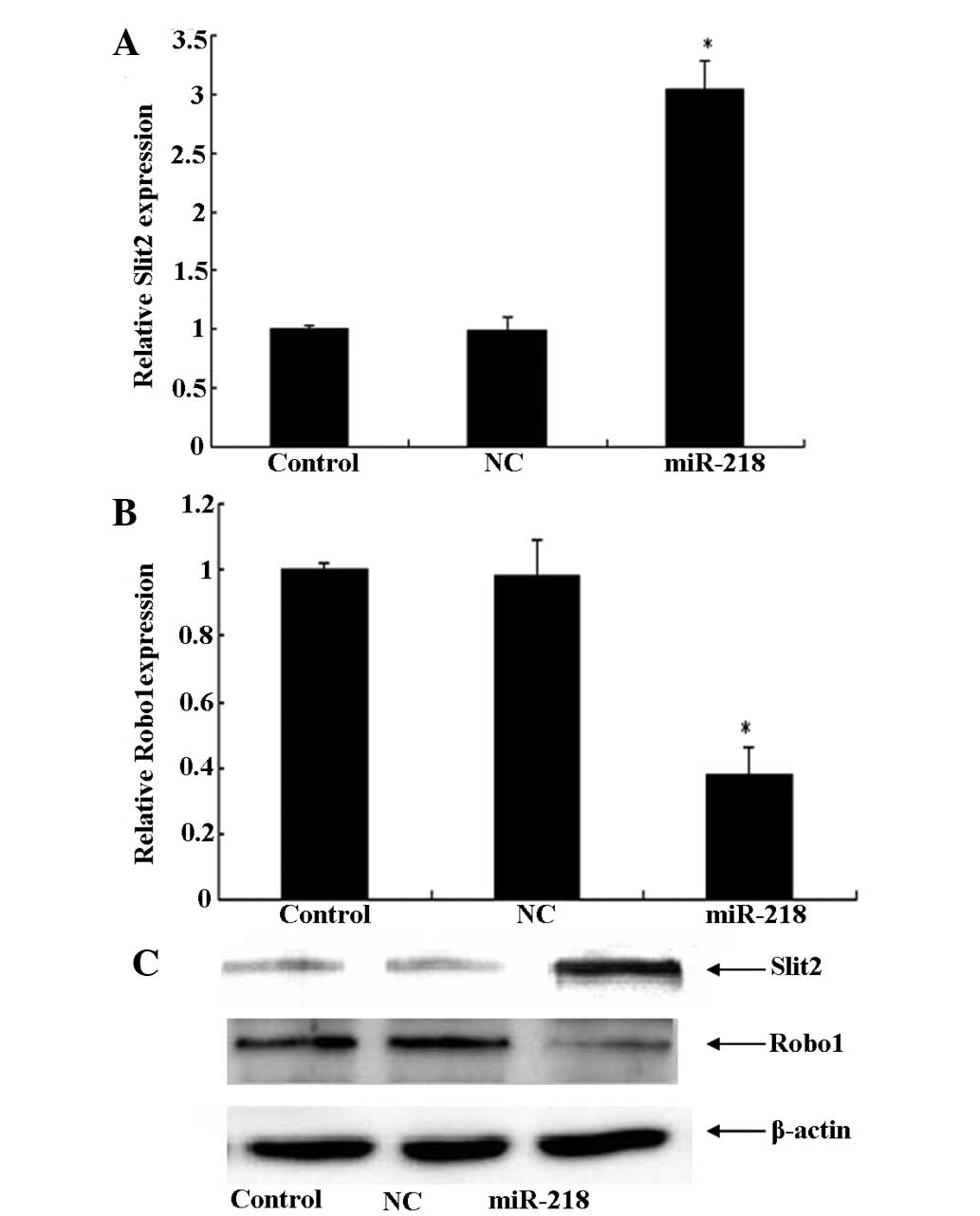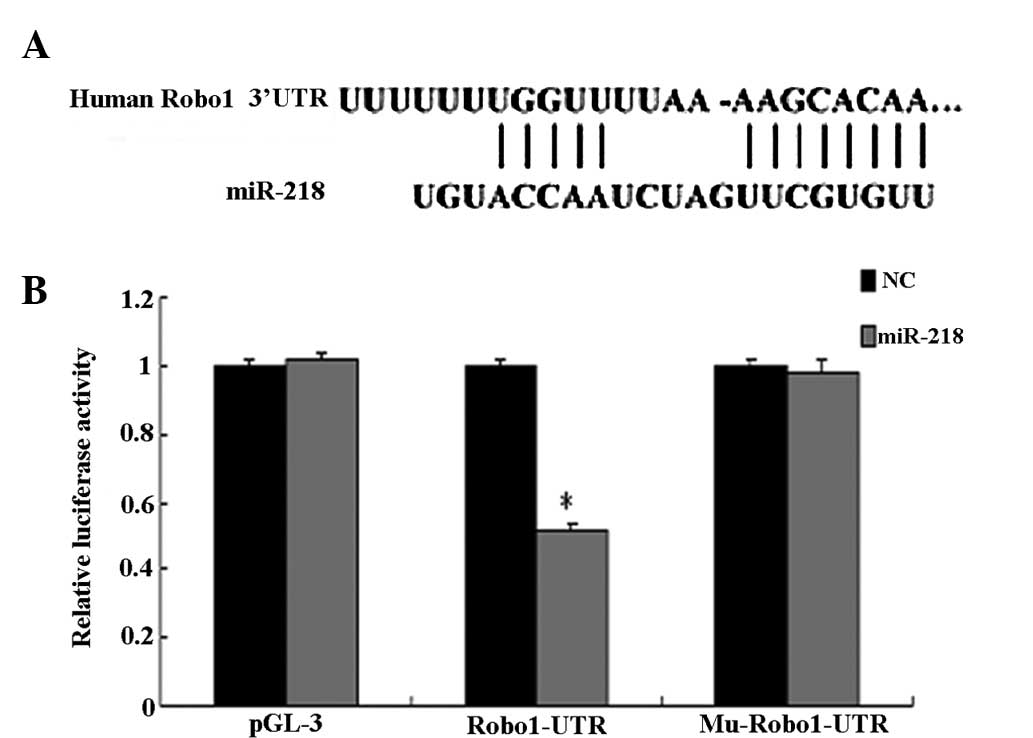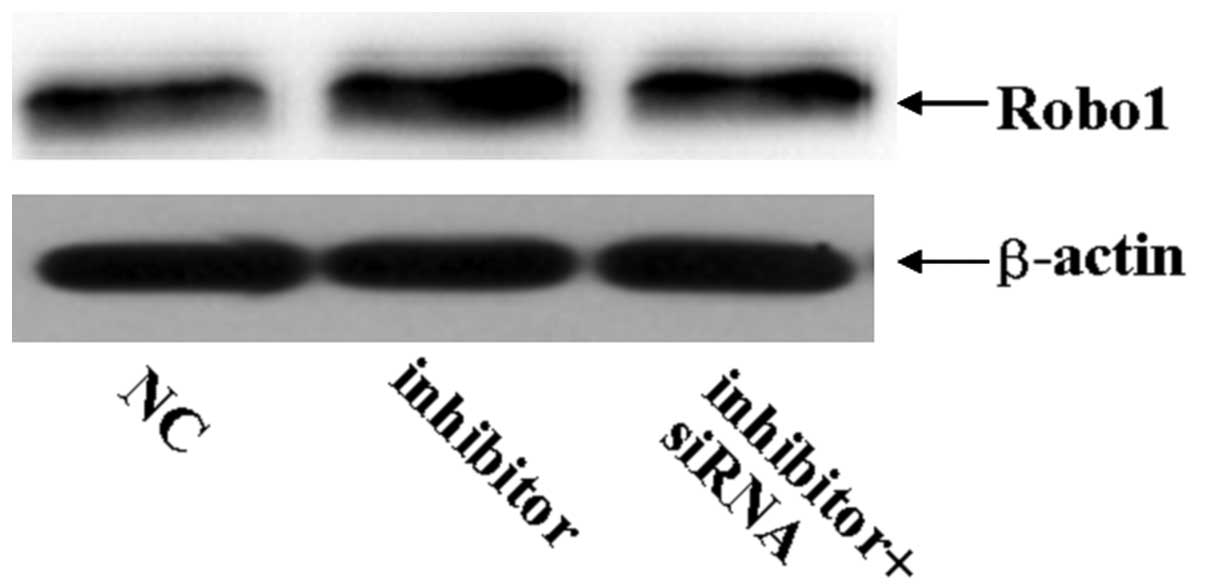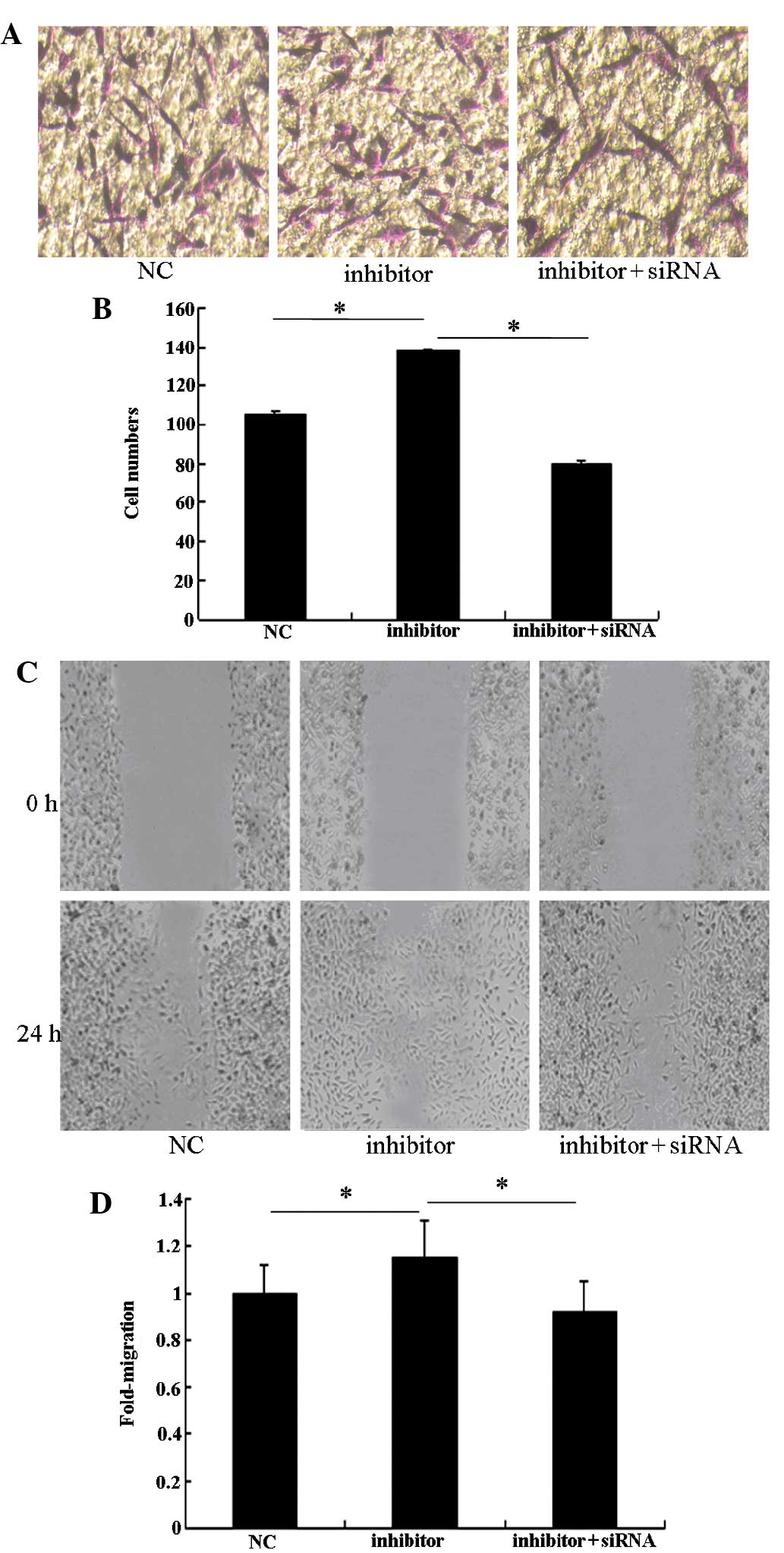miR-218 inhibits the migration and invasion of glioma U87 cells through the Slit2-Robo1 pathway
Retraction in: /10.3892/ol.2023.14068
- Authors:
- Published online on: January 27, 2015 https://doi.org/10.3892/ol.2015.2904
- Pages: 1561-1566
-
Copyright: © Gu et al. This is an open access article distributed under the terms of Creative Commons Attribution License.
Abstract
Introduction
Human gliomas originate from neural mesenchymal cells and account for 4–50% of nervous system tumors (1). The 2007 World Health Organization (WHO) classification (2) classifies astrocytomas as well-differentiated low-grade diffuse astrocytoma (WHO grade I-II), anaplastic astrocytoma (WHO grade III) and glioblastoma multiforme (GBM; WHO grade IV). Despite the use of aggressive surgery combined with radiation, chemotherapy and biological therapy (3), glioma remains a notable therapeutic challenge. There is an acknowledged requirement for novel therapeutic approaches based on an increased understanding of the biological and molecular nature of glioma (4).
microRNAs (miRNAs) are a class of short, non-coding single-stranded RNA molecules that are 22–25 nucleotides in length. miRNAs negatively regulate gene expression through the post-transcriptional silencing of target messenger RNAs (mRNAs), which occurs due to complementary binding (5,6). An increasing quantity of evidence has indicated an important role for miRNAs in the development of various cancers, including gliomas, and miRNAs have been associated with tumor suppressor and oncogenic activities (7,8). Among these miRNAs, miRNA 218 (miR-218) has been demonstrated to be downregulated in human GBM specimens compared with the adjacent tumor-free brain tissue (9–12). Accumulated evidence has revealed that upregulation of miR-218 can inhibit tumor cell invasion and proliferation in glioma cells by altering the expression of multiple target genes (12–15).
Previous studies have found that miR-218 inhibited the invasion and metastasis of gastric cancer by targeting the roundabout, axon guidance receptor, homolog 1 (Robo1) receptor and suppressing nasopharyngeal cancer progression through the downregulation of survivin and the Slit homolog 2 (Slit2)-Robo1 pathway (16,17). In the present study we examined how miR-218 affects the migration and invasion of glioma cells and the mechanism for miRNA-mediated direct suppression of the Slit2-Robo1 pathway in gliomas.
Materials and methods
Clinical samples
Tumor specimens were obtained from patients who underwent positive debulking surgery in the Neurosurgery Department of the The First Affiliated Hospital of Soochow University (Suzhou, China) between 2011 and 2013. The diagnosed gliomas were reviewed by an experienced neuropathologist, using histological slides, according to the 2007 WHO classification. The present study comprised 20 grade I–II, 20 grade III and 20 grade IV glioma samples. In addition, 10 normal brain tissue samples were obtained from internal decompression of patients with cerebral injury. This study complied with the requirements of the ethics committee of The First Affiliated Hospital of Soochow University and informed consent was obtained from all participants.
Cell lines and transfection
Primary normal human astrocytes (NHA) were purchased from Sciencell Research Laboratories (Carlsbad, CA, USA). The U251, U87, SNB19 and LN229 glioma cell lines were obtained from the Institute of Biochemistry and Cell Biology (Shanghai Institutes for Biological Sciences, Chinese Academy of Science, Shanghai, China). The cells were maintained in RPMI-l640 medium containing 10% FBS, 50 units/ml penicillin G, and 250 μg/ml streptomycin (all purchased from Invitrogen Life Technologies, Carlsbad, CA, USA) in a humidified atmosphere containing 5% CO2, at 37°C. Transfections with miR-218 were performed in serum-free medium 24 h subsequent to plating, using Lipofectamine 2000 (Invitrogen Life Technologies). After 6 h, the cells were placed in complete medium and maintained at 37°C in a 5% CO2 atmosphere.
Small interfering (si)RNA and transfection assays
Robo1-specific siRNA (forward, 5′-GGAUGUAUUUGCAAC AAGATT-3′ and reverse, 5′-UCUUGUUGCAAAUACAUC CTT-3′) was chemically synthesized by Qiagen (Hilden, Germany). The U87 cells were transfected with siRNA (HiPerFect Transfection Reagent; Qiagen) according to the manufacturer’s instructions. Briefly, the original stock of the siRNA was suspended in the siRNA suspension buffer provided by the manufacturer and stored at −20°C until use. On the day of transfection, 1×105 cells were seeded in six-well plates (Corning Inc., Corning, NY, USA) with a total volume of 1,000 μl per well. siRNA was then gently introduced into the cells by adding 4 μl Oligofectamine™ Transfection Reagent (Invitrogen Life Technologies) and 5 μl siRNA (20 nM) per well. Non-silencing siRNA (GE Dharmacon, Lafayette, CO, USA) (forward, 5′-UUCUCCGAACGUGUCACGUTT-3′ and reverse, 5′-ACGUGACACGUUCGGAGAATT-3′) was used to control any effects of the transfection reagent and siRNA. The in vitro assays described herein were performed 24 h after transfection.
RNA extraction and reverse transcription-quantitative polymerase chain reaction (RT-qPCR)
Total RNA, including miRNA, was extracted from the cultured cells or fresh glioma cancer tissues using TRIzol reagent (Invitrogen Life Technologies), according to the manufacturer’s instructions. The expression level of miR-218 was quantified using an miRNA-specific TaqMan miRNA Assay kit (Applied Biosystems, Foster City, CA, USA). U6 small nuclear RNA was used as an internal control. The mRNA expression of Slit2 and Robo1 was analyzed by qPCR, using the SYBR-Green method. All protocols were performed according to the manufacturer’s instructions and the results were normalized to the expression of GAPDH. The primer sequences were as follows: Slit2 forward, 5′-ACCTCT TGGCCAATCCTTTT-3′ and reverse, 5′-GAAGTCCTGAAT GGCCACAT-3′; Robo1 forward, 5′-GCCACCAGCAAGGAT GTATT-3′ and reverse, 5′-CCTGTAACATGGGCTGGAGT-3′; and GAPDH forward, 5′-TCGGAGTCAACGGATTTGG-3′ and reverse, 5′-CATGGGTGGAATCATATTGGA-3′.
Western blotting
The cells were lysed in 1% Nonidet P-40 lysis buffer for 48 h following exposure to LY294002 or vehicle treatment. The homogenates were clarified by centrifugation at 20,000 × g for 15 min, at 4°C, and the protein concentrations were determined with a bicinchoninic acid protein assay kit (Pierce Biotechnology, Inc., Rockford, IL, USA). SDS-PAGE was performed on 40 μg of protein from each sample, the gels were transferred to polyvinylidene fluoride membranes (Merck Millipore, Darmstadt, Germany) and incubated with primary polyclonal goat anti-human Slit2 and rabbit anti-human Robo1 antibodies (1:200 dilution; sc-26599 and sc-25672, respectively, Santa Cruz Biotechnology, Inc., Dallas, TX, USA) followed by incubation with horseradish peroxidase-conjugated monoclonal goat anti-rabbit and donkey anti-goat secondary antibodies (1:1,000 dilution; cat nos. sc-2004 and sc-2020, respectively; Zymed Life Technologies, Carlsbad, CA, USA). The membranes were stripped using 1X phosphate-buffered saline with Tween 20 buffer (Wuhan Boster Biological Technology, Ltd., Wuhan, China) and reprobed with a primary monoclonal mouse anti-rabbit antibody against GAPDH (1:1,000 dilution; Bioworld, Nanjing, China). The protein bands were quantitated by densitometry using the gel analysis software ImageJ (National Institutes of Health, Bethesda, MA, USA. The values were normalized to GAPDH expression.
Transwell assay and scratch-wound assay
Cell invasion was determined using Transwell and scratch-wound assays. For the Transwell assay, the appropriate oligonucleotides were transfected into the cells according to the aforementioned protocol. Subsequent to incubation for 48 h, 3×104 cells were transferred to the top of the Matrigel-coated invasion chambers (BD Biosciences, San Jose, CA, USA) in a serum-free Dulbecco’s modified Eagle’s medium (DMEM). DMEM containing 10% fetal bovine serum was added to the lower chamber. After 24 h, the non-invading cells were removed, and the invading cells were fixed using 95% ethanol, stained with 0.1% crystal violet and images were captured under a ×100 magnification. The tests were repeated in three independent experiments. For the scratch-wound assay, the appropriate oligonucleotides were transfected into the cells in six-well plates. The cell layers were then scratched using a 200 μl sterile pipette tip to form wound gaps. The wound location in the six-well plates was marked. Images of the cells were captured to record the wound width at 0 and 24 h, and the images were captured at the marked wound location to measure the migratory ability of the cells.
Luciferase assay
The 3′-UTR sequence of Robo1 predicted to interact with miR-218 or a mutated sequence with the predicted target sites was synthesized and inserted into the XbaI and FseI sites of a pGL3 control vector (Promega Corporation, Madison, WI, USA). These constructs were named pGL3-Robo1–3′-UTR and pGL3-Robo1–3′-UTR-mut, respectively. For the reporter assay, the U87 cells were plated onto 24-well plates and transfected with pGL3-Robo1–3′-UTR or pGL3-Robo1–3′-UTR-mut and P-miR-218 or P-miR-control vectors using the FuGENE HD transfection reagent (Promega Corporation). A Renilla luciferase vector pRL-SV50 (Promega Corporation) was cotransfected to normalize the differences in transfection efficiency. Subsequent to 48 h transfection, the cells were harvested and assayed using the Dual-Luciferase Reporter Assay System (Promega Corporation), according to the manufacturer’s instructions. Transfection was repeated in triplicate in three independent experiments.
Target prediction and network analysis
Robo1 was identified as a notable novel target of miR-218 using the conventional prediction tool, TargetScan (www.targetscan.org; Whitehead Institute for Biomedical Research, Cambridge, MA, USA).
Statistical analysis
Experimental data were presented as the mean ± standard deviation. All analyses were performed using a two-tailed Student’s t-test performed on SPSS software, version 12.0 (SPSS, Inc., Chicago, IL, USA). P<0.05 was considered to indicate a statistically significant difference.
Results
miR-218 is downregulated in glioma tissues
To analyze the expression levels of miR-218, a qPCR analysis of miR-218 expression was conducted in the U251, U87, SNB19 and LN229 glioma cell lines. The present results revealed that miR-218 is downregulated in all glioma cell lines compared with the NHA cells (P<0.05). In addition, when miR-218 expression was measured in 10 normal brain tissue and 60 glioma tissue samples, it was observed that the expression level of miR-218 was significantly decreased in the glioma tissues, particularly in grade III/IV glioma tissues, compared with the normal brain tissues (Fig. 1). This result demonstrates that miR-218 expression decreases markedly between normal brain tissue and low grade to GBM tissue. Overall, the present results indicate that miR-218 is downregulated in glioma cell lines and glioma tissues.
Upregulation of miR-218 inhibited cell invasion in U87 cells
As invasiveness is one of the pathophysiological features of human malignant gliomas, the effects of miR-218 on the invasiveness and migration of glioma cells were checked by Transwell and scratch-wound assays. An in vitro Matrigel invasion assay revealed that the invasiveness of U87 cells transfected with the miR-218 mimic was suppressed compared with control and NC groups (Fig. 2A and B). The results of the in vitro wound healing assay revealed that miR-218 significantly attenuated the migration of U87 cells compared with control and NC groups (Fig. 2C and D). This finding indicates that the upregulation of miR-218 inhibits the invasive ability of glioma cells in vitro.
Upregulation of miR-218 reduces Robo1 expression via the inactivation of Slit2-Robo1 signaling
Development of invasiveness by malignant glioma cells involves multiple genetic alterations in signaling pathways. Numerous studies have reported that the Slit2-Robo1 signaling channels can inhibit glioma invasion and migration. However, the specific roles of Slit2/Robo1 in cancer cell invasion have not yet been completely elucidated in vivo. The present study also observed, using qPCR and western blot analysis, that treatment with the miR-218 mimic for 24 h significantly upregulated the expression of Slit2, which was followed by a decrease in Robo1 (Fig. 3). These results indicate that miR-218 reduced the expression of Robo1 via the inactivation of Slit2-Robo1 signaling.
Robo1 is a functional downstream target of miR-218
A luciferase reporter assay further confirmed the direct interaction between miR-218 and the 3′-UTR of Robo1 mRNA (Fig. 4). The luciferase activity for the wild-type 3′-UTR of Robo1 was significantly inhibited by co-transfection with miR-218 mimics compared with constructs containing mutated 3′-UTRs. The present study demonstrated that Robo1 is a direct target of miR-218.
Robo1 siRNA can imitate the role of miR-218 in U87 glioma cells
To assess the role of Robo1 in the miR-218-dependent inhibition of cell migration and invasion, miR-218 inhibitor was transfected into U87 cells treated with Robo1 siRNA. As expected, Robo1 protein expression was significantly reduced by the specific Robo1 siRNA (Fig. 5). The enhanced invasive ability of miR-218 inhibitor-transfected U87 cells declined when Robo1 siRNA was co-transfected with the miR-218 inhibitor (Fig. 6). These results indicate that Robo1 is essential for miR-218-dependent cell migration and invasion.
Discussion
Malignant gliomas are diffuse tumors that are extremely invasive and usually multifocal. Glioma possesses a dismal prognosis, with a median survival of ~16 months (18). The ability for single tumor cell infiltration, which involves the extension of tendrils of the tumor several centimeters away from the main tumor mass, is one of the major obstacles for the effective treatment of gliomas, as this infiltration results in incomplete surgical removal and contributes to the high frequency of tumor recurrence (19). Despite the increasing quantity of evidence that demonstrates the promotion of glioma cell infiltration into the brain parenchyma by various stimuli, the mechanisms underlying the dysregulation of cell motility during tumor invasion by the insidious glioma cells have yet to be elucidated (20). As a result, exploring novel treatment methods is an urgent clinical challenge for neuroscientists.
Previous studies have revealed that miR-218 expression is often downregulated in several human cancers, including gastric cancer, lung squamous cell carcinoma, malignant astrocytomas and medulloblastomas, which indicates that miR-218 may function as a tumor suppressor (21–23). Studies have identified that the ectopic expression of miR-218 contributes to the inhibition of proliferation, invasion and migration in glioma cells, as well as the induction of apoptosis by downregulating the gene that was directly targeted by miR-218 (12–15). Firstly, miR-218 inhibits the expression of the target gene inhibitor of nuclear factor κB (NF-κB) kinase β, and in a dose-dependent manner, inhibits the expression of NF-κB, whilst reducing the expression of matrix metalloproteinase (MMP) 9 and inhibiting the invasion and migration ability of glioma cells (12). Secondly, epidermal growth factor receptor-coamplified and overexpressed protein (ECOP) has been identified as a functional downstream target gene of miR-218 that can regulate NF-κB transcription activity and is associated with the apoptotic response. Overexpression of miR-218 can restrain the activity of NF-κB through ECOP, thus inducing glioma cell apoptosis and inhibiting the activity, proliferation and tumorigenicity of glioma cells (13). Thirdly, the expression of lymphoid enhancer-binding factor 1 (LEF1) and MMP-9 in the high grade glioma group is extremely high, while the expression in the low-grade glioma group is extremely low, and is negatively correlated with the expression of miR-218. Overexpression of miR-218 inhibits the Wnt/LEF1 signaling pathways that lead to a reduction in MMP-9 synthesis, inhibiting tumor invasion (14). Finally, the abnormal expression of miR-218 in glioma cells decreased, but there was an abnormal increase in cyclin-dependent kinase (CDK) 6 expression, with the expression level of the two being negatively correlated. Overexpression of miR-218 in the glioma cell lines can inhibit CDK6 expression and glioma cell proliferation and promote its apoptosis (15).
Tumor development is a complex multi-step process that includes malignant tumor invasion and metastasis (24). The development of invasiveness in malignant glioma cells involves several genetic alterations within signaling pathways. Numerous studies have reported that the Slit2/Robo1 signaling channels can inhibit glioma invasion and migration. An in vitro study performed by Mertsch et al (25) identified, using a modified Boyden chamber assay, that the Slit2/Robo1 system serves as a chemorepellent for glioma cells, indicating that glioblastoma cells migrate away from increased Slit2 concentrations and prompt Robo1-positive glioma cell invasion along gray matter tracts and into white matter, including the corpus callosum (25). A previous in vivo study revealed that ectopic expression of Slit2 in SNB19 cells attenuates cell migration and invasion (20). These results indicate that Slit2/Robo1 can inhibit glioma invasion and migration in vivo and in vitro. Slit2 may also be a tumor suppressor gene that inhibits the migration and invasion of tumor cells and this inhibition appears to be mediated by Robo1 (20). Previous studies identified that miR-218 inhibited invasion and metastasis of gastric cancer by targeting the Robo1 receptor and suppressed nasopharyngeal cancer progression through the downregulation of survivin and the Slit2-Robo1 pathway (16,17).
In the present study, Robo1 was identified as a notable novel target of miR-218 using the conventional prediction tool TargetScan (www.targetscan.org). The expression levels of miR-218, Robo1 and Slit2 were detected in 70 tissue samples, consisting of normal brain tissue and low- and high-grade glioma tissues, using RT-qPCR and western blot analysis. It was found that the expression of miR-218 and Slit2 was always inverse to that of Robo1. Notably, the mRNA and protein levels of Robo1 were significantly decreased and the mRNA and protein levels of Slit2 were significantly increased subsequent to the transfection of miR-218 mimics into U87 cells. Furthermore, it was found that miR-218 was involved in modulation of the Slit2-Robo1 signaling pathway and downregulation of Robo1 expression by directly targeting the Robo1 3′-UTR. In addition, Robo1 siRNA can reduce the invasive ability of the cells subsequent to its enhancement by the exogenous expression of the miR-218 inhibitor. Overall, the present results indicate that miR-218 inhibits the migration and invasion of glioma cells through the Slit2-Robo1 signaling pathway. Therefore, the development miR-218 as a biomarker for glioma or as a potential therapeutic candidate for miRNA replacement therapy is extremely promising (26,27).
References
|
Dallol A, Krex D, Hesson L, Eng C, Maher ER and Latif F: Frequent epigenetic inactivation of the SLIT2 gene in gliomas. Oncogene. 22:4611–4616. 2003. View Article : Google Scholar : PubMed/NCBI | |
|
Louis DN, Ohgaki H, Wiestler OD, et al: The 2007 WHO classification of tumours of the central nervous system. Acta Neuropathol. 114:97–109. 2007. View Article : Google Scholar : PubMed/NCBI | |
|
Grauer OM, Wesseling P and Adema GJ: Immunotherapy of diffuse gliomas: biological background, current status and future development. Brain Pathol. 19:674–693. 2009. View Article : Google Scholar : PubMed/NCBI | |
|
Dontula R, Dinasarapu A, Chetty C, et al: MicroRNA 203 Modulates Glioma Cell Migration via Robo1/ERK/MMP-9 Signaling. Genes Cancer. 4:285–296. 2013. View Article : Google Scholar : PubMed/NCBI | |
|
Bartel DP: MicroRNAs: target recognition and regulatory functions. Cell. 136:215–233. 2009. View Article : Google Scholar : PubMed/NCBI | |
|
Long JM and Lahiri DK: Advances in microRNA experimental approaches to study physiological regulation of gene products implicated in CNS disorders. Exp Neurol. 235:402–418. 2012. View Article : Google Scholar : PubMed/NCBI | |
|
Park S and James CD: ECop (EGFR-coamplified and overexpressed protein), a novel protein, regulates NF-kappaB transcriptional activity and associated apoptotic response in an IkappaBalpha-dependent manner. Oncogene. 24:2495–2502. 2005. View Article : Google Scholar : PubMed/NCBI | |
|
Xu B, Hsu PK, Karayiorgou M and Gogos JA: MicroRNA dysregulation in neuropsychiatric disorders and cognitive dysfunction. Neurobiol Dis. 46:291–301. 2012. View Article : Google Scholar : PubMed/NCBI | |
|
Godlewski J, Nowicki MO, Bronisz A, Williams S, et al: Targeting of the Bmi-1 oncogene/stem cell renewal factor by microRNA-128 inhibits glioma proliferation and self-renewal. Cancer Res. 68:9125–9130. 2008. View Article : Google Scholar : PubMed/NCBI | |
|
Silber J, Lim DA, Petritsch C, et al: MiR-124 and miR-137 inhibit proliferation of glioblastoma multiforme cells and induce differentiation of brain tumor stem cells. BMC Med. 6:142008. View Article : Google Scholar : PubMed/NCBI | |
|
Rao SA, Santosh V and Somasundaram K: Genome-wide expression profiling identifies deregulated miRNAs in malignant astrocytoma. Mod Pathol. 23:1404–1417. 2010. View Article : Google Scholar : PubMed/NCBI | |
|
Song L, Huang Q, Chen K, et al: miR-218 inhibits the invasive ability of glioma cells by direct downregulation of IKK-β. Biochem Biophys Res Commun. 402:135–140. 2010. View Article : Google Scholar : PubMed/NCBI | |
|
Xia H, Yan Y, Hu M, et al: MiR-218 sensitizes glioma cells to apoptosis and inhibits tumorigenicity by regulating ECOP-mediated suppression of NF-κB activity. Neuro Oncol. 15:413–422. 2013. View Article : Google Scholar : | |
|
Liu Y, Yan W, Zhang W, et al: MiR-218 reverses high invasiveness of glioblastoma cells by targeting the oncogenic transcription factor LEF1. Oncol Rep. 28:1013–1021. 2012.PubMed/NCBI | |
|
Zhang JM, Sun CY, Yu SZ, et al: Relationship between miR-218 and CDK6 expression and their biological impact on glioma cell proliferation and apoptosis. Zhonghua Bing Li Xue Za Zhi. 40:454–459. 2011.(In Chinese). PubMed/NCBI | |
|
Tie J, Pan Y, Zhao L, et al: MiR-218 inhibits invasion and metastasis of gastric cancer by targeting the Robo1 receptor. PLoS Genet. 6:e10008792010. View Article : Google Scholar : PubMed/NCBI | |
|
Alajez NM, Lenarduzzi M, Ito E, et al: MiR-218 suppresses nasopharyngeal cancer progression through downregulation of survivin and the SLIT2-ROBO1 pathway. Cancer Res. 71:2381–2391. 2011. View Article : Google Scholar : PubMed/NCBI | |
|
Stupp R, Mason WP, van den Bent MJ, et al; European Organisation for Research and Treatment of Cancer Brain Tumor and Radiotherapy Groups; National Cancer Institute of Canada Clinical Trials Group. Radiotherapy plus concomitant and adjuvant temozolomide for glioblastoma. N Engl J Med. 352:987–996. 2005. View Article : Google Scholar : PubMed/NCBI | |
|
Furnari FB, Fenton T, Bachoo RM, et al: Malignant astrocytic glioma: genetics, biology, and paths to treatment. Genes Dev. 21:2683–2710. 2007. View Article : Google Scholar : PubMed/NCBI | |
|
Yiin JJ, Hu B, Jarzynka MJ, et al: Slit2 inhibits glioma cell invasion in the brain by suppression of Cdc42 activity. Neuro Oncol. 11:779–789. 2009. View Article : Google Scholar : PubMed/NCBI | |
|
Martinez I, Gardiner AS, Board KF, et al: Human papillomavirus type 16 reduces the expression of microRNA-218 in cervical carcinoma cells. Oncogene. 27:2575–2582. 2008. View Article : Google Scholar : | |
|
Petrocca F, Visone R, Onelli MR, et al: E2F1-regulated microRNAs impair TGFbeta-dependent cell-cycle arrest and apoptosisin gastric cancer. Cancer Cell. 13:272–286. 2008. View Article : Google Scholar : PubMed/NCBI | |
|
Yanaihara N, Caplen N, Bowman E, et al: Unique microRNA molecular profiles in lung cancer diagnosis and prognosis. Cancer Cell. 9:189–198. 2006. View Article : Google Scholar : PubMed/NCBI | |
|
Xu Y, Li WL, Fu L, et al: Slit2/Robo1 signaling in glioma migration and invasion. Neurosci Bull. 26:474–478. 2010. View Article : Google Scholar : PubMed/NCBI | |
|
Mertsch S, Schmitz N, Jeibmann A, et al: Slit2 involvement in glioma cell migration is mediated by Robo1 receptor. J Neurooncol. 87:1–7. 2008. View Article : Google Scholar | |
|
Bader AG, Brown D and Winkler M: The promise of microRNA replacement therapy. Cancer Res. 70:7027–7030. 2010. View Article : Google Scholar : PubMed/NCBI | |
|
Roth P, Wischhusen J, Happold C, et al: A specific miRNA signature in the peripheral blood of glioblastoma patients. J Neurochem. 118:449–457. 2011. View Article : Google Scholar : PubMed/NCBI |




